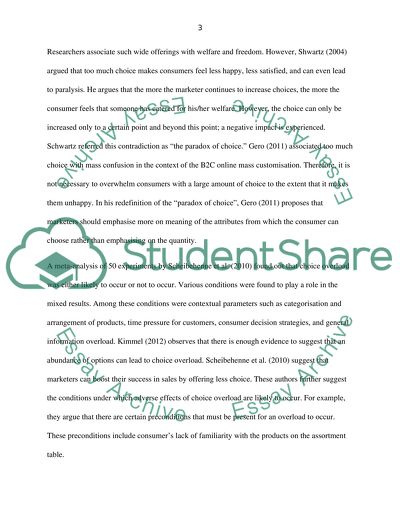Cite this document
(“Choice Overload: Solution through Offering Less Choice Essay”, n.d.)
Choice Overload: Solution through Offering Less Choice Essay. Retrieved from https://studentshare.org/marketing/1691784-using-expert-view-and-examples-to-support-your-points-determine-the-extent-to-which-consumers-are-experiencing-a-choice-overload-and-evaluate-whether-offering-less-product-choice-seems-to-be-a-successful-strategy-for-many-of-todays-organisations
Choice Overload: Solution through Offering Less Choice Essay. Retrieved from https://studentshare.org/marketing/1691784-using-expert-view-and-examples-to-support-your-points-determine-the-extent-to-which-consumers-are-experiencing-a-choice-overload-and-evaluate-whether-offering-less-product-choice-seems-to-be-a-successful-strategy-for-many-of-todays-organisations
(Choice Overload: Solution through Offering Less Choice Essay)
Choice Overload: Solution through Offering Less Choice Essay. https://studentshare.org/marketing/1691784-using-expert-view-and-examples-to-support-your-points-determine-the-extent-to-which-consumers-are-experiencing-a-choice-overload-and-evaluate-whether-offering-less-product-choice-seems-to-be-a-successful-strategy-for-many-of-todays-organisations.
Choice Overload: Solution through Offering Less Choice Essay. https://studentshare.org/marketing/1691784-using-expert-view-and-examples-to-support-your-points-determine-the-extent-to-which-consumers-are-experiencing-a-choice-overload-and-evaluate-whether-offering-less-product-choice-seems-to-be-a-successful-strategy-for-many-of-todays-organisations.
“Choice Overload: Solution through Offering Less Choice Essay”, n.d. https://studentshare.org/marketing/1691784-using-expert-view-and-examples-to-support-your-points-determine-the-extent-to-which-consumers-are-experiencing-a-choice-overload-and-evaluate-whether-offering-less-product-choice-seems-to-be-a-successful-strategy-for-many-of-todays-organisations.


